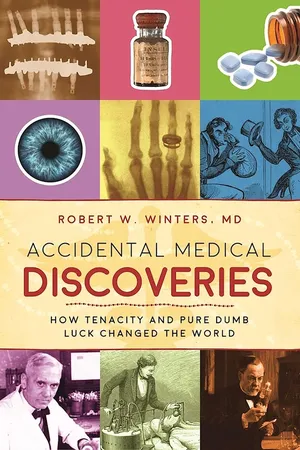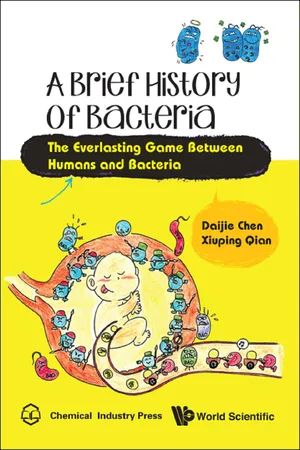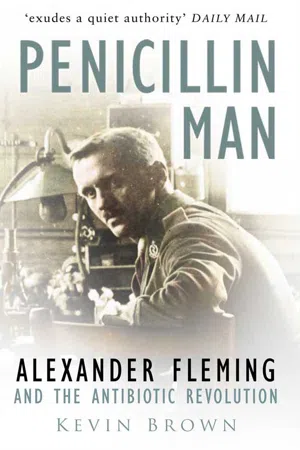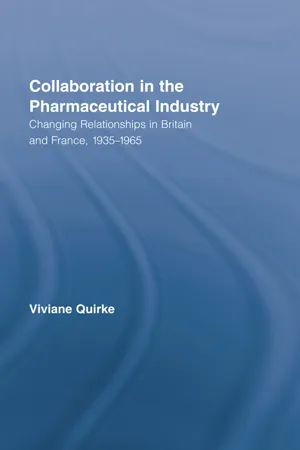Biological Sciences
Alexander Flemming
Alexander Fleming was a Scottish biologist and pharmacologist who is best known for his discovery of the antibiotic substance penicillin in 1928. This breakthrough revolutionized the treatment of bacterial infections and had a profound impact on medicine and public health. Fleming's work laid the foundation for the development of numerous other antibiotics, saving countless lives and shaping the field of microbiology.
Written by Perlego with AI-assistance
Related key terms
4 Key excerpts on "Alexander Flemming"
- eBook - ePub
Accidental Medical Discoveries
How Tenacity and Pure Dumb Luck Changed the World
- Robert W. Winters(Author)
- 2016(Publication Date)
- Skyhorse(Publisher)
The Birth of Penicillin & the Disarming of Microbes . London: Allen & Unwin, 1970.Hobby, G. Penicillin: Meeting the Challenge. New Haven: Yale University Press, 1985.Lax, E. The Mold in Dr. Florey’s Coat: The Story of the Penicillin Miracle. New York: Henry Holt, 2004.MacFarlane, G. Alexander Fleming: The Man and the Myth . Oxford: Oxford University Press, 1984.2 The term penicillium was derived from Latin penicillium, or resembling a painter’s brush. Fleming thought that the term penicillin sounded better than “mold juice,” which was used during the preliminary studies.3 Lysozyme (Greek lysein + en , within in, and zyme , ferment) is an enzyme with anti-bacterial properties. It is normally present in saliva, sweat, breast milk, and tears. It has no medical uses.Passage contains an image CHAPTER 11 Streptomycin: A Major Dispute Al has hit pay dirt. —Doris Jones, graduate student Introduction
I n early 1947, a doctor made the following notes in the chart of a twenty-one-year-old woman who had an advanced stage of tuberculosis of the lung. Treatment had begun on November 20, 1944, and lasted four months, during which she received five courses of a new treatment. She improved markedly, and two years later, her case was closed as arrested pulmonary tuberculosis. She subsequently married and had three children.Streptomycin was the drug that this young woman received, and she was the one of the very first patients to benefit from this miraculous drug. Many hundreds of thousands of other tuberculosis patients followed. These grateful patients may not have realized that a graduate student studying under a microbiologist named Selman Waksman, working at Rutgers University in New Jersey, had discovered streptomycin, which was the miracle drug that had arrested her disease. Waksman was a deliberate, systematic scientist who spent his professional life studying the microbes in soil. Waksman provided close supervision of the work of several graduate students, one of whom, Albert Schatz, would discover this life-giving medicine. - eBook - ePub
A Brief History of Bacteria
The Everlasting Game Between Humans and Bacteria
- Daijie Chen, Xiuping Qian(Authors)
- 2017(Publication Date)
- WSPC(Publisher)
β-lactam antibiotics is the main drug against bacterial infections today. Apart from little allergic reactions, these drugs have almost no other toxic or side effects. This is because of the mechanism of these drugs is to inhibit formation of cell walls. As human cell has no cell walls, these drugs can exercise much selective virulence.A great and ordinary man
Although before Fleming, some people had already observed some bacteria could inhibit bacterial growth, there had been no miracle. The discovery of penicillin undoubtedly makes Fleming a great man. However, from discovery to application, Fleming’s penicillin was buried for 10 years. Apart from objective environment at the time, subjective conditions also restrained research on penicillin. After all, great men are also ordinary men.Penicillin is hard to extract, and its activity is highly unstable. Under conditions at that time, extraction of penicillin remained a major challenge even for specialized biochemists. Fleming was a biologist. He was no all-rounder. Due to his lack of chemical knowledge, he could not extract penicillin from the culture media. Without purified penicillin, his research could not proceed, nor could it be applied to clinical practices.Influenced by the restraints in science of that time, Fleming believed that test results on animals could not reflect possible results in human, or rather, it was unreliable to use animal test results as an instruction for human medical practices. This wrong thought dominated Fleming and his laboratory. The result was their insufficient confidence in clinical application of penicillin.In addition, immunology was fast developing during 1920s and 1930s. Many infectious diseases could be effectively prevented through immunological methods; on the other hand, the new sulfonamides drugs demonstrated magic effects in treating many bacterial infections. Therefore, many scientists put the highlight of research on immunology or the development of sulfonamides drugs. - eBook - ePub
- Kevin Brown(Author)
- 2005(Publication Date)
- The History Press(Publisher)
EIGHT Challenge for AmericaT he end of the Second World War found Fleming back in the United States from which he had made a mad dash home to London at the outbreak of war six years previously. Then he had been one of a number of delegates at a microbiological congress. Now, his second visit to North America took on more of the character of a triumphal tour, as the modest Scot whose discovery had seemingly vanquished infection was greeted everywhere with all the honour more usually given to a victorious general touring the battlefields on which his reputation had been won. Universally he was greeted as the man who had given the world penicillin, though he had been warned in advance not to expect such treatment: ‘I had been told in many quarters it was believed that penicillin originated in America but that I cannot accept, as everywhere in the public press as well as in scientific quarters, I have received my full share of credit for the initiation of the work.’1 For Fleming it was the opportunity to see for himself the great advances that had been made in North America to enable mass production of penicillin to become a reality.What struck Fleming most from his triumphant American tour was that ‘It is evident that they think more of penicillin in America than in England’.2 Everywhere he went in the summer of 1945 he was lionised during a series of press conferences, radio interviews and public lectures orchestrated for him by John Cameron, his minder from the British Mission, who confessed that he had fallen ‘completely under his spell’.3 His American tour was a success from the moment he set sail on the Aquitania and gave a lecture on the discovery of penicillin to his fellow travellers in mid-voyage. Despite his dislike of such lecturing, he was coming to tailor what he said to his audience, increasingly non-medical. He also joined his shipmates in conversation though was perhaps a better listener than talker.4 - eBook - ePub
Collaboration in the Pharmaceutical Industry
Changing Relationships in Britain and France, 1935–1965
- Viviane Quirke(Author)
- 2012(Publication Date)
- Routledge(Publisher)
112 His collaboration with ICI, the only industrial consultancy he ever took, arose as a result of the penicillin experience and had the aim of speeding up the production of cephalosporin. However, in the end it fulfilled little practical purpose, and Florey was reduced to playing the role of a bystander, watching the company carry out its research projects independently of his advice.The following account of Florey’s involvement with the cephalosporin project, which led him to agree to consult for ICI, is drawn from Edward Abraham’s personal recollections, and from his papers deposited in the Bodleian archive. In Abraham’s own words, ‘in the early 1950s an ominous cloud was beginning to appear’.113 Penicillin-resistant strains of staphylococcus were spreading in hospitals. This prompted a widespread search for new antibiotics.In 1945, a professor of bacteriology in Sardinia, Giuseppe Brotzu, had found a species of fungus that showed activity against several Gram-negative as well as Gram-positive bacteria (the only antibiotic that was active against Gram-negative bacteria was then streptomycin). Having been unable to interest the Italian pharmaceutical industry in his discovery, he was advised by a British colleague to contact the MRC, which directed him to Florey. In 1948, Florey received from Brotzu a sample of culture of the fungus and a paper in which he described his work. At the School of Pathology, a number of researchers, including Norman Heatley and Edward Abraham, began to study the organism, applying the knowledge and techniques developed in the course of their research on penicillin. However, unlike penicillin, from the very beginning the production of culture fluids was entrusted to others, in this instance the MRC’s new Antibiotic Research Station. It would continue to supply the School of Pathology until 1960, by which time industry was both willing and able to take over this role.
Learn about this page
Index pages curate the most relevant extracts from our library of academic textbooks. They’ve been created using an in-house natural language model (NLM), each adding context and meaning to key research topics.



